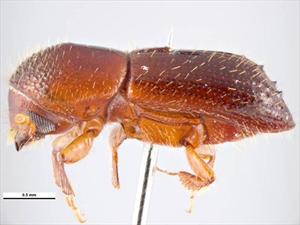- Worldwide distribution. In Australia, New Zealand, most Pacific island countries.
- Major pest causing tunnels and staining in distressed, fallen trees and sawn timber. All stages completed inside tunnels, feeding on fungus introduced by adults as they bore.
- Spread: adults emerge and fly short distances. Longer distance spread with domestic and international movement of logs and timber.
- Biosecurity: high chance of introduction in logs and timber. Countries yet free should set traps at ports, and ensure crates, pallets and dunnage compliant with international standard: (http://www.fao.org/3/a0450e/a0450e.pdf).
- Cultural control: remove felled trees as quickly as possible, and convert to seasoned timber.
- Chemical control: not appropriate; insecticides unlikely to reach the beetles deep inside trees, logs or timber.






